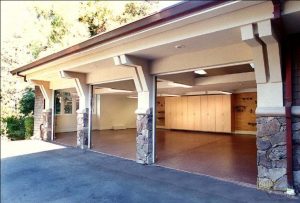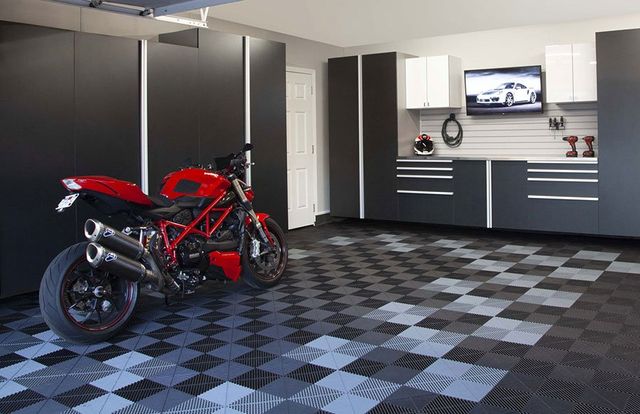
Consider steel garage shelving if you need somewhere to store your tools or other items. This low-maintenance storage solution can help you make the most of your garage and can accommodate heavy loads. You can easily move them around to accommodate different sizes.
Consider several factors when choosing garage shelving to achieve the best results. A product should be able to be installed in eight-foot sections. A unit should be able to support 300 pounds per shelf. Also, inquire about warranties. Some manufacturers offer warranties up to 10 years. It's a good idea to read customer reviews before making your purchase.
You need to inspect your garage shelves, no matter if you're installing it for the first or second time. They can become sagging and cause problems. It's important to inspect them each month.

There are many types of garage shelving available, but it's important to find the right one for your needs. It is important to choose a sturdy material and ensure the shelves fit into your space. You might be able install a wall-mounted shelving system depending on how big your garage is. Wall-mounting kits can be an option for those who are concerned about the stability and safety of their current shelving system.
Among the many types of garage shelving, wire and metal shelving are likely to be the most durable. These shelving are not intended to mount on the garage walls. Fortunately, you can upgrade your existing shelving to include wheels, which will allow you to move your products around.
To prevent moisture from getting into wire and metal shelves, you may need a liner. You can also protect your shelves with a rustproof coating. Quality products should be backed by a warranty. You may not need to maintain your product much, but it's still important to have a warranty.
NewAge Products Wall Mounted Steel Shelf will fit in any corner of your garage, or above your garage door rails. It is made from heavy gauge steel and comes with a 1-inch safety lip.

A ceiling-mounted shelving unit is an option to the standard wall-mounted system. While these are great for maximising storage space in your garage they can also make your space feel cramped. A combination of wire and laminate shelving is another option. Laminated products will warp under heavy loads. However, they're inexpensive and provide a solid surface for keeping tools in order.
One of the best things about garage shelving is that they are easy to assemble. Even if you have no previous experience, it shouldn't take more than 20 minutes to assemble a unit. You can be certain that the unit fits your needs because most units come pre-built. You will also be pleased to know that they are very easy and simple to clean.
FAQ
What should you do with your cabinets?
It depends on whether your goal is to sell or rent out your house. You'll need to remove the cabinets and refinish them if you plan to sell. This gives buyers the illusion that they are brand new, and allows them to envision their kitchens once they move in.
If you are looking to rent your house, it is best to leave the cabinets as-is. Renters often complain about dealing with dirty dishes and greasy fingerprints left behind by previous tenants.
You can also consider painting the cabinets to make them look newer. Use a high-quality primer. Low-quality paints can become brittle over time.
What is the difference between a remodel and a renovation?
Remodeling is any major transformation of a room or portion of a bedroom. A renovation is a minor change to a room or a part of a room. For example, a bathroom remodeling project is considered a major one, while an upgrade to a sink faucet would be considered a minor job.
A remodel involves replacing an entire room or part of a whole room. Renovating a room is simply changing one aspect of it. A kitchen remodel might include the replacement of countertops, sinks as well as appliances, lighting, and other accessories. A kitchen remodel could also include painting the walls or installing new lighting fixtures.
How much would it be to renovate a house vs. what it would cost you to build one from scratch?
A home's contents are removed, such as walls, floors, ceilings and plumbing. It's often necessary when you're moving to a new house and want to make changes before you move in. Due to so many factors involved in the process of gutting a property, it can be very costly. Your job may require you to spend anywhere from $10,000 to $20,000 to gut your home.
The process of building a home involves the construction of a house from one frame to another. Next, the builder adds walls, flooring and roofing. This is done usually after purchasing lots. Building a home is normally much less expensive than gutting, costing around $15,000-$30,000.
It all comes down to what you want to do in the space. You will probably have to spend more to gut a house. It doesn't matter if you want a home built. You can build it the way you want it instead of waiting for someone else to come in and tear everything up.
How much does it cost to gut and renovate a kitchen completely?
You might wonder how much it would be to remodel your home if you have been considering the idea.
Kitchen remodels typically cost between $10,000 to $15,000. You can still save money on your kitchen remodel and make it look better.
Preparing ahead can help you cut down on your costs. This includes choosing a style and color scheme that suits your lifestyle and finances.
A skilled contractor is another way to reduce costs. A professional tradesman knows exactly how to handle each step of the construction process, which means he or she won't waste time trying to figure out how to complete a task.
It's a good idea to evaluate whether your existing appliances should be replaced or preserved. Kitchen remodeling projects can cost thousands more if you replace appliances.
It is possible to choose to buy used appliances, rather than buying new ones. Because you don't need to pay for installation, buying used appliances can help you save some money.
Shopping around for fixtures and materials can help you save money. Many stores offer discounts during special events, such as Black Friday or Cyber Monday.
How long does it usually take to remodel your bathroom?
A bathroom remodel typically takes around two weeks. However, it all depends on how big the project is. Some jobs, such installing a vanity and adding a shower stall, can take only a couple of days. Larger projects like removing walls and installing tile floors or plumbing fixtures can take many days.
As a general rule, you should allow at least three days for each bedroom. For example, if you have four bathrooms you would need twelve days.
What does it cost to tile a shower?
You might want to go big if you are going to do it yourself. It's an investment to remodel a full bathroom. However, quality fixtures and materials are worth the long-term investment when you consider how beautiful a space will be for many years.
The right tiles can make a huge difference in how your room looks and feels. This guide will help you select the right tiles for your project, no matter how small or large.
First, decide which type of flooring you'd like to install. Common choices include ceramics and porcelain as well as stone and natural wooden. Next, choose a style such as a classic subway tile or a geometric pattern. Finally, pick a color palette.
If you are remodeling a large bathroom, you'll likely need to match the tile with the rest. For example, you may opt for white subway tile in the kitchen and bath area while choosing darker colors in other rooms.
Next, determine the size of the project. Is it time for a small update to the powder room? Would you prefer to add a walk in closet to your master bedroom?
Once you have determined the scope of your project, go to local shops and look at samples. You can then get a feel of the product and how it is installed.
For great deals on porcelain tiles, you can shop online. Many retailers offer discounts for bulk purchases and free shipping.
Statistics
- Attic or basement 10 – 15% (rocketmortgage.com)
- 55%Universal average cost: $38,813Additional home value: $22,475Return on investment: 58%Mid-range average cost: $24,424Additional home value: $14,671Return on investment: (rocketmortgage.com)
- 5%Roof2 – 4%Standard Bedroom1 – 3% (rocketmortgage.com)
- About 33 percent of people report renovating their primary bedroom to increase livability and overall function. (rocketmortgage.com)
- Following the effects of COVID-19, homeowners spent 48% less on their renovation costs than before the pandemic 1 2 (rocketmortgage.com)
External Links
How To
Is a permit required for home renovation?
Make sure your renovations are done correctly. All construction projects that involve exterior wall changes are subject to building permits. This includes adding an addition, remodeling your kitchen, replacing windows, etc.
If you decide to renovate your home, but without a permit from the building department, there may be severe consequences. If anyone is injured during the process of renovation, you could face fines or even criminal action.
Most states require all people working on residential structures to have a building permit. Many counties and cities also require homeowners that they apply for a permit before starting any construction project.
Most building permits are issued by local government agencies such as the county courthouse, city hall, and town hall. However, they can also be obtained online and by telephone.
A building permit would be the best because it will ensure that the project conforms to local safety standards, fire codes, as well as structural integrity regulations.
For instance, a building inspector will ensure that the structure meets current building code requirements, including proper ventilation, fire suppression systems, electrical wiring, plumbing, heating, air conditioning, and more.
In addition, inspectors will check to ensure that the planks used to construct the deck are strong enough to support the weight of whatever is placed upon them. Inspections will also check for cracks or water damage that could cause structural instability.
Contractors are allowed to begin the renovations after the building permit has been granted. Contractors who fail to get the permits could face fines or even arrest.